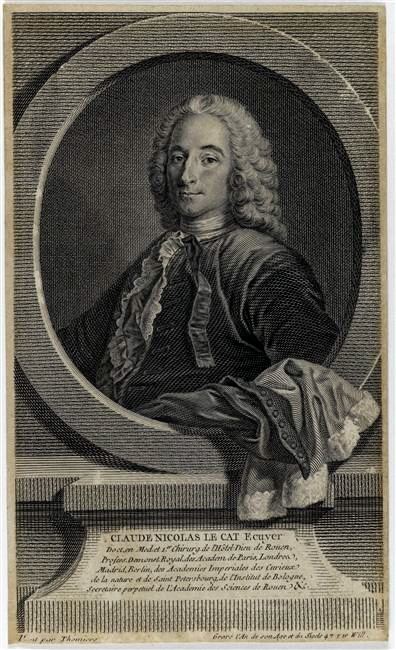Name Claude-Nicolas Cat Influenced by Jacob B. Winslow Fields Medicine, Surgery | Influences Jacob B. Winslow Thesis 1733 | |
 | ||
Born September 6, 1700Blerancourt (France) ( 1700-09-06 ) Institutions Hotel-Dieu hospital (Rouen) Spouse Marie-Marguerite Champossin | ||
Claude-Nicolas Le Cat (6 September 1700 - 20 August 1768) was a French surgeon.
Contents
Biography
Le Cat was born in Blerancourt (Picardy). He was the son of Claude Le Cat, a surgeon, and Anne-Marie Meresse, the daughter of a surgeon. He studied anatomy and surgery first with his father then in Paris from 1726.
In 1728, he was appointed surgeon to the Archbishop of Rouen Louis de La Vergne-Montenard de Tressan, friend of Louis XV, then in 1731 deputy head surgeon at the Hotel-Dieu hospital in Rouen when he was not yet Master surgeon.
He obtained his medical doctorate in Reims University in 1733, then became next year Master surgeon in Rouen.
He commenced lecturing on anatomy and surgery, and in 1736 received the title of royal professor and demonstrator. In 1744 he founded the "Academie royale des sciences, belles lettres et arts" in Rouen, becoming its lifelong secretary for the class of sciences and arts.
In 1742, he married Marie-Marguerite Champossin. Their only daughter, Charlotte-Bonne, married the surgeon Jean-Pierre David (fr), who succeeded Le Cat in all his offices.
Louis XV granted him the rank of ecuyer in 1762 in recognition of his services.
He died in Rouen in 1768 aged 67.
Works
In 1731, his interest in replicating human anatomical forms and movements stimulated Vaucanson to begin work on his first automaton.
In 1732, he performed lateral lithotomy approach to removing bladder stones using the technique invented by Frere Jacques Beaulieu and improved by William Cheselden. He developed an instrument for lithotomy, the "Gorgeret cystotome". Le Cat deserve credit for the first removal of bladder polyp through the dilated urethra.
He also effected a great advance in cataract surgery.
His reputation in France and Europe is reflected by his numerous academy prizes, publications, and surgical notoriety.
